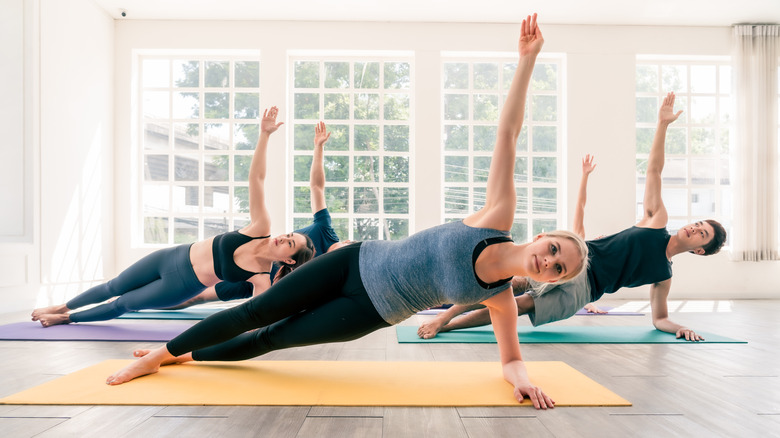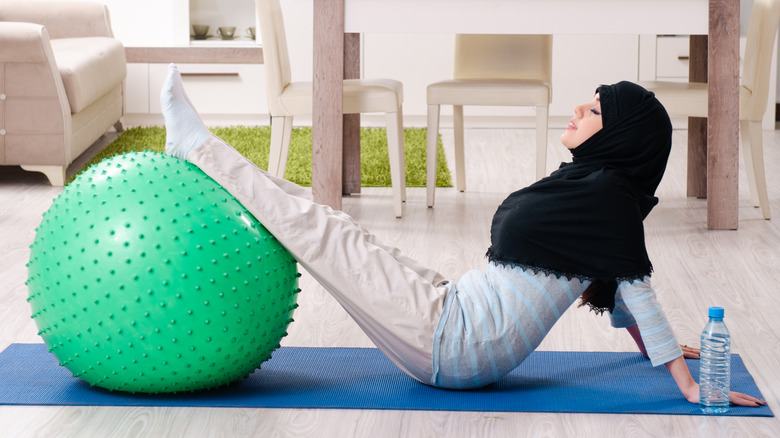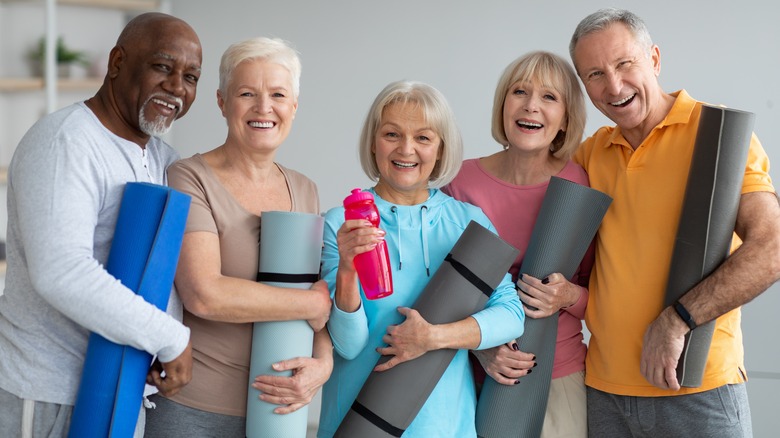Tips For Getting The Most Out Of Your First Pilates Class
If you're new to Pilates, you may be feeling overwhelmed entering your first class. If you don't know what to expect for your introduction to this much-hyped workout, don't worry, because we've got you covered! Cleveland Clinic reports that Pilates has been around for over a century and is a workout that can positively impact your entire body. Created by Joseph Pilates, the practice of Pilates was originally curated for injured dancers and continues to serve as both a rehabilitative and preventative technique for many people. As a low-impact and easily modifiable workout, it's a great option for nearly everyone.
Pilates is a workout that combines flexibility, balance, full-body strength, and movement coordination in ways that are low-impact, meaning that the exercises don't pressure the joints or rely on forceful movements to create strength and muscle tone (according to LiveStrong). Additionally, Pilates has been compared to yoga because it can create a better mind-body connection. While you will probably be sore after your first class, continuing with Pilates as part of your exercise regimen has been proven to increase core and abdominal strength, flexibility, and balance while decreasing symptoms of fatigue, depression, and anxiety (via Self).
Taking the leap into your first Pilates class is the beginning of what could be an exciting new fitness journey. There are different types of Pilates and a variety of classes to choose from, so knowing about the specific workouts can help you choose the right one for you.
Choosing your workout
There are two primary forms of Pilates: mat Pilates and reformer Pilates (per Self). Mat Pilates is performed on a yoga mat and is a great introduction for beginners. Taking a mat Pilates class can introduce you to the terms and positions comprising Pilates workouts, while a class on the reformer machine might be overwhelming for a first-timer.
Pilates reformers are machines designed specifically for Pilates exercises and utilize resistance to enhance workouts. By first taking a mat Pilates class, you can learn how to support yourself in Pilates positions before adding in the resistance from the reformer. As you build strength, the reformer can be an excellent way to achieve a quality workout. If you do venture into a reformer class for your first foray into Pilates, look for a class called "classic reformer" or a private one-on-one class.
In addition to mat Pilates and reformer classes, there are many forms of Pilates fusion classes that you may find available in your local area or on virtual platforms. Pilates can be blended with workouts like barre, yoga, and mild cardio. Even in a traditional Pilates class, you may find that the instructor includes elements from yoga. Verywell Fit recommends finding instructors trained in all of the exercises being combined in a fusion class.
How to prepare for your first Pilates class
Preparing for your first class is important in making your introduction to Pilates successful. The first step is knowing your body and whether you have any injuries or medical conditions that might need modifications during your Pilates workout (per BetterHealth Channel). If needed, consult with your doctor beforehand to ask if Pilates is right for you, and if there are any movements or exercises you should avoid. When you get to your first class, make certain that you let the instructor know if you require modifications during parts of the workout regimen. Don't worry if you do need to modify exercises or positions. Everyone is unique, and many people modify various exercises due to their individual health.
When getting ready for your first Pilates class, knowing what to wear and what to bring will help you both be prepared and feel confident. Clothing for Pilates usually includes leggings that go past the knee, and apparel that is stretchy and non-restrictive, but not baggy (via LiveStrong). Athletic wear, especially clothing that is moisture-wicking, is preferred over fabrics like cotton, which can become uncomfortable and heavy when sweat is absorbed. You'll also want to bring a hand towel or sports towel to wipe off sweat during class. Check with the Pilates studio you'll be attending to see if you should bring your own yoga mat, or if they provide mats for participants to use. You'll definitely want to bring a water bottle to stay hydrated throughout your workout.



